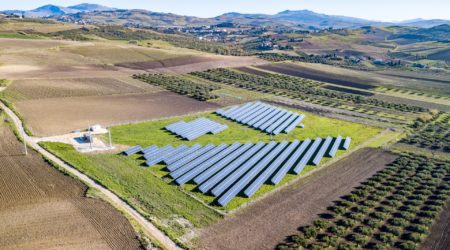Building a Digital Finance for Climate Resilience Ecosystem: Insights from Industry Leaders

The IPCC report released this week confirms what communities, households, and individuals around the world are already experiencing — the effects of climate change are here, and are getting worse. With only 3 months until COP26, the IPCC report provides a strong call to action for governments and non-state actors to take drastic action to limit warming to below 1.5C. Alongside calls for reduction of emissions, the report warns of more intense and frequent extreme weather and heat events, an increase in heavy rainfall in some places and severe drought in others, and a rise in sea level which threatens the billions of people residing and working in coastal areas. Even in scenarios where we reduce emissions to below 1.5C, the current climate changes being felt will worsen until we reach net-zero emissions, and the report warns that some may be irreversible. To withstand and build back stronger from these changes, we need to dramatically scale access to climate resilience solutions.
We believe that digital finance and fintech can act as critical enablers for climate resilience solutions that can help communities prepare for and withstand the shocks and long-run changes predicted by the IPCC report. We see the development of an innovation ecosystem to enable the growth and development of these solutions and last-mile delivery channels as an urgent and critical step in building resilience to climate shocks at scale.
We believe that learning from the innovation ecosystems around the microfinance, PAYGo solar, and inclusive fintech sectors provides a strong framework for enabling the creation and development of climate resilience solutions for vulnerable populations in emerging markets today. Five key stakeholders that were critical to the development and scale of these ecosystems – innovators, catalytic funders, investors, enablers, and government/ policymakers – will be similarly critical to the successful development and scaling of new business models, products, and ideas for climate resilience. A key consideration, however, is how these stakeholders can take action now to accelerate this new ecosystem’s development, given the urgent action required.
We brought together a group of more than 30 stakeholders, drawing from their experiences in the development of these adjacent ecosystems and perspectives on how to better orchestrate and accelerate the way forward when it comes to climate resilience, over the course of two roundtable discussions. The participants’ feedback highlighted a number of key requirements needed to prepare us to navigate this journey successfully.
Defining the “True North.” Where are we going, and how will we know we are on track to get there? The answer to this question is essential to a positive start, and fortunately there is an increasing body of related work to draw from and link to. It includes the need to ensure clear, common definitions early on, including a taxonomy of prospective solutions that can help to bring understanding and action in the right directions, key KPIs and metrics for success, as well as the basic data infrastructure needed to capture, process and report to various stakeholders. The sum total of these elements should serve also to define the ‘latitude and longitude’ of the specific points of intersection and adjacency where inclusive digital finance can deliver meaningful climate adaptation and resilience outcomes quickly, clearly and efficiently.
Building the “Waze” for climate resilience roadmapping. Due to the need to move fast, adapt and learn quickly, as well as the desire to avoid costly duplication, creating a ‘crowd-sourcing’ learning and information-sharing ecosystem focused on innovators and implementers working on the front-lines of the problem will be essential. Unlike past development models, which relied on static or backward-looking reports and research models with extended timelines, climate resilience requires a closer-to-real-time model that enables rapid adaptation and course-corrections based on observable, real-world outcomes.
Inspiring more innovators to enter the race. There are not enough entrepreneurs currently ‘in the race.’ High-potential innovators are stuck on the sidelines, in some cases because they don’t have sufficient support to take the risk of getting behind the wheel of high-potential business concepts or innovations. In other cases, spirited innovators and entrepreneurs simply need an idea. In the early days, these innovators can benefit from taxonomies and maps of business opportunities, or profiling of technologies or startups that are tackling a certain challenge for inspiration or direct technology transfer.
Providing greater access to early, catalytic, high-risk capital at the earliest stages. Fast-moving, early risk-taking philanthropic capital can provide running room for those talented entrepreneurs who are willing to take this risk, to test and demonstrate new business models and technology adaptations. Most likely, these innovation sponsors will be from the foundation and/or philanthropic sector, but could include high-net-worth individuals with the latitude and risk appetite to ‘move fast and break things,’ and align with fast-moving entrepreneurial opportunity timelines. A critical mass of such early ‘catalytic funders’ are needed to step up and start writing early checks, with a wide enough net to get more entrepreneurs into the field and accelerate the prospective innovation pipeline. It’s also critical to enable both donors and investors to connect and coordinate from the beginning.
Developing the right financing tools to enable growth. Promising early innovations will require access to agile, adaptive capital. This means capital that is suited to growing, scaling and replicating promising business models and tech adaptations into high-risk geographies and segments, where the need is greatest but returns may come slowly. Almost certainly, this will require blended capital approaches – not just in the form of grants vs equity. Creative use of instruments including convertible debt, revenue-based financing, common vs preferred equity positions, and patient capital vs rent-seeking VC models, early on will be essential to jump-starting the race to resilience.
Providing the right tools to guide the journey. While there are a lot of unknowns on this journey, there is an opportunity to go prepared with operational guidelines and resources, as well as vehicles for collecting data and sharing insights, from the beginning. In combination with a clear industry-building framework and action roadmap, this can help to enable faster, more efficient uptake and delivery of impactful business and tech solutions when and where they are needed.
Looking at the long-term opportunity along the funding continuum. While early blended finance models can get things off to a fast start, creating early opportunities to engage the full continuum of capital providers and instruments will be required. This will give the best possible conditions for smooth take-off to scale and replication for promising innovations and ventures by positioning capital access that is ample, timely and accessible.
And not least…..
Viewing end-users as co-pilots, not passengers. Vulnerable communities are already experiencing direct impacts of the climate crisis and innovating to respond with whatever limited tools they currently have at their disposal. Entrepreneurs, funders and donors, investors, enablers, policy-makers and regulators need to take a demand-driven approach to designing, implementing and supporting the solutions ecosystem that must emerge. This will help to ensure digital finance-enabled tools and approaches don’t fall into the trap of the ‘build it and they will come’ mentality that often pervades the tech space. This includes ensuring that client protection and data protection principles and mechanisms are embedded in design and delivery processes from the start, and solutions and delivery channels are designed to be inclusive and built with the most vulnerable in mind.
Four billion human beings, or nearly half of the world’s population, are deemed vulnerable to the foreseeable effects of the unfolding current climate crisis all around us today. Digital finance solutions are currently deployed and being used by nearly two billion people in the emerging market world alone, many of whom are also climate vulnerable. A deliberate, focused, and concerted effort to ensure tools and technologies are made available to these people over the next ten years will not stop the crisis from happening, but it may go a long way to ensuring that these communities are more prepared when shocks do occur, and better equipped not only to weather them, but also to thrive in their aftermath. What we do today, and in the next months and years, will make all the difference in what happens to these generations to come. The race is underway, the time is now to get onboard and be a contributor.
In the coming months we will be publishing a set of tools designed to address key knowledge gaps and generate awareness in the ways that digital finance can achieve a step-change in the market potential (depth, breadth, speed) of climate resilience solutions, and a Digital Finance for Climate Resilience Framework for Action for shifting this nascent ecosystem from incremental to catalytic action and collaboration. Stay tuned!



